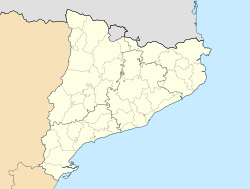- Tortosa
-
For the city in Syria called Tortosa during the crusades, see Tartous.
Tortosa — Municipality — 
Flag
Coat of armsLocation in Catalonia Coordinates: 40°48′46″N 0°31′24″E / 40.81278°N 0.52333°ECoordinates: 40°48′46″N 0°31′24″E / 40.81278°N 0.52333°E Country Spain Community Catalonia Province Tarragona Comarca Baix Ebre Government – Mayor Ferran Bel i Accensi Area – Total 218.45 km2 (84.3 sq mi) Elevation 12 m (39 ft) Population (2010) – Total 34,473 – Density 157.8/km2 (408.7/sq mi) Demonym Tortosí, tortosina Time zone CET (UTC+1) – Summer (DST) CEST (UTC+2) Tortosa (Catalan pronunciation: [turˈtozə], locally: [toɾˈtoza]. Latin: Dertusa or Dertosa, Arabic: طرطوشة Ṭurṭūšah) is the capital of the comarca of Baix Ebre, in the province of Tarragona, in Catalonia, Spain.
Tortosa is located at 12 metres above sea level, by the Ebre river, protected on its northern side by the mountains of the Cardó Massif, of which Buinaca, one of the highest peaks, is located within Tortosa's municipal term.
Before Tortosa, across the river, rise the massive Ports de Tortosa-Beseit mountains. The area around Mont Caro and other high summits are ofen covered with snow in the winter.
Contents
Population centers
- Bítem, 1.139; includes Santa Rosa
- Campredó, 1.168; includes La Font d'en Quinto
- Jesús, 3.755
- Els Reguers, 679
- Tortosa, 27.131
- Vinallop, 363, includes Mianes
History
Tortosa is probably identical to the ancient Hibera, capital of Ilercavonia. This may be the ancient settlement the remains of which have been found on the hill named Castillo de la Zuda. In Roman times, the town adopted the name Dertosa. After more than 400 hundred years of Muslim rule, the city was conquered by the Count Ramon Berenguer IV of Barcelona in 1148, as part of the Second Crusade. Because of the crusading appeal made by Pope Eugene III and his representative Nicholas Brakespear (the future Pope Hadrian IV), the siege received the aid of crusaders from multiple nationalities (Genovese, Anglo-Normans, Normans, Southern-French, Germans, Flemish and Dutch), who were on their way to the Holy Land. The siege of Tortosa was narrated by the Genovese chronicler and diplomat Caffaro.
After its conquest, the city and its territory were divided among the victors, with multiple lands being granted to foreign crusaders and to the military and religious orders.[1]
Formerly there was a railway line between Tortosa and Alcañiz, opening a communication gate between this region and Aragon.[2] Construction work began in 1891, but it was haphazard and the first trains between Alcañiz and Tortosa began only in 1942. The last stretch between Tortosa and Sant Carles de la Ràpita was never completed before the line was terminated by RENFE in 1973.[3]
Main sights
- Castle of San Juan, or Zuda, commanding the city from a 59 m-high hill. Though the Roman were the first to fortify the place, the current structure date to Muslim caliph Abd ar-Rahman III. After the conquest by Ramon Berenguer IV, Count of Barcelona, in 1148, it became a residence of the Montcada and the Knights Templar, and from the 13th century it became a royal mansion.
- The Cathedral, begun in 1347 and consecrated in 1597.
- Bishop Palace
- Convent of Santa Clara, founded in 1283.
- Lonja (market), the oldest in Aragon.
- Montagut Palace
- Despuig Palace (14th century)
- Oliver de Boteller Palace (15th century)
Demography
Historical population of Tortosa 1991 1996 2001 2004 29,452 30,088 28,933 31,979 See also
References
- ^ Lucas Villegas-Aristizabal, "Anglo-Norman involvement in the conquest of Tortosa and Settlement of Tortosa, 1148-1180", Crusades 8 (2009), pp. 63-129.
- ^ Historia de la línea de La Puebla de Híjar-Alcañiz-Tortosa-Sant Carles de la Ràpita
- ^ El Punt - El cruel divorci entre Tortosa i el tren
External links
- Official website (Catalan)
- Tourism Official website(English)
- Video on Tortosa
- Information - Generalitat de Catalunya (Catalan)
- Statistical information - Institut d'Estadística de Catalunya (Catalan)
- Monasteries in Catalonia. Tortosa (Catalan)
- The Tortosa Forum
Municipalities of Baix Ebre L'Aldea · Aldover · Alfara de Carles · L'Ametlla de Mar · L'Ampolla · Benifallet · Camarles · Deltebre · Paüls · El Perelló · Roquetes · Tivenys · Tortosa · Xerta Categories:
Categories:- Baix Ebre
- Municipalities in Tarragona
- Populated places in Tarragona
Wikimedia Foundation. 2010.



